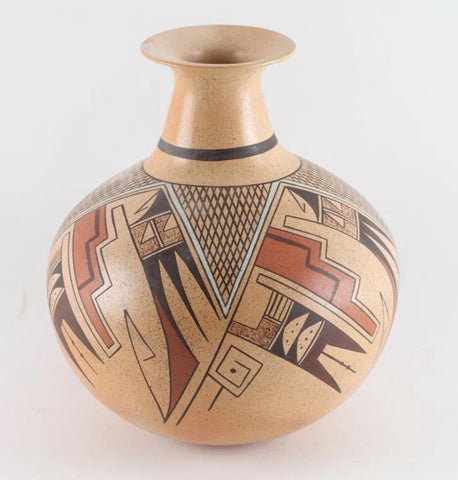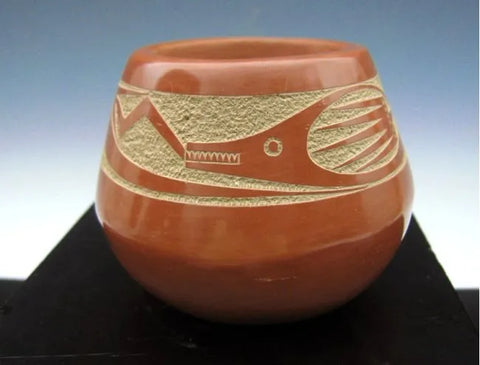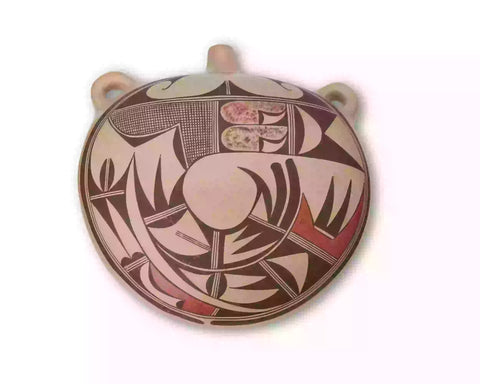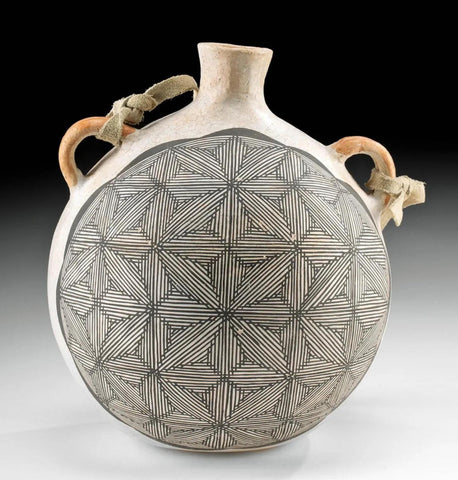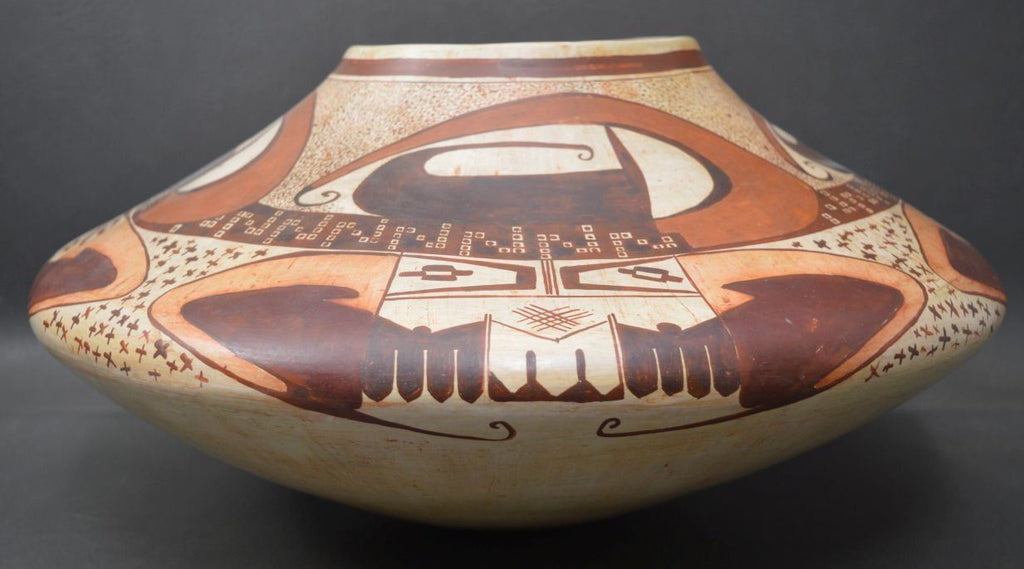
Native American, Vintage Hopi Polychrome Pottery Jar, Attributed To Mark Tahbo, Ca 1980's-90's, #1523 SOLD
$ 4,300.00
Native American, Vintage Hopi Polychrome Pottery Jar,Attributed To Mark Tahbo, Ca 1980's-90's, #1523
Description: #1523, Native American, Vintage Hopi Poly Chrome Pottery Jar,Attributed To Mark Tahbo, Ca 1980's-90's. Hand coiled and painted polychrome design pottery jar.
Dimensions: 8" x 17".
Condition: Excellent for the age of the piece, unsigned.
Provenance. From a major Dallas, TX, collection.
Hopi Pueblo artist Mark Tahbo made extremely thin-walled pottery vessels and polished them to perfection. His designs were executed with precision. Because of his fine workmanship, he received numerous awards at the Heard Museum Annual Indian Fair. He also had been a consistent award winner at the annual Santa Fe Indian Market. In 1991, he won Overall Prize at Indian Market. In 1992 he was awarded Best of Division at the Heard Museum Indian Fair. Awards continued to be presented to him in 1993 and 1994 and later.
Mark Tahbo (b.1958-2017) was a Hopi-Tewa and a member of the Tobacco Clan. He had been an active potter since 1978. He came from a long line of outstanding potters, the most famous of whom was his great-grandmother Grace Chapella. He was also the grandson of her daughter Alma Tahbo. His siblings were potters too. Grace Chapella, of course, is famous for living to 106 years and continuing to make pottery past her 100th birthday. Mark passed away on December 22, 2017. (Source: Adobe Gallery)
“Pueblo pottery is made using a coiled technique that came into northern Arizona and New Mexico from the south, some 1500 years ago. In the four-corners region of the US, nineteen pueblos and villages have historically produced pottery. Although each of these pueblos use similar traditional methods of coiling, shaping, finishing and firing, the pottery from each is distinctive.
Various clay's gathered from each pueblo’s local sources produce pottery colors that range from buff to earthy yellows, oranges, and reds, as well as black. Fired pots are sometimes left plain and other times decorated—most frequently with paint and occasionally with appliqué. Painted designs vary from pueblo to pueblo, yet share an ancient iconography based on abstract representations of clouds, rain, feathers, birds, plants, animals and other natural world features.
Tempering materials and paints, also from natural sources, contribute further to the distinctiveness of each pueblo’s pottery. Some paints are derived from plants, others from minerals. Before firing, potters in some pueblos apply a light colored slip to their pottery, which creates a bright background for painted designs or simply a lighter color plain ware vessel. Designs are painted on before firing, traditionally with a brush fashioned from yucca fiber.
Different combinations of paint color, clay color, and slips are characteristic of different pueblos. Among them are black on cream, black on buff, black on red, dark brown and dark red on white (as found in Zuni pottery), matte red on red, and polychrome—a number of natural colors on one vessel (most typically associated with Hopi). Pueblo potters also produce undecorated polished black ware, black on black ware, and carved red and carved black wares.
Making pueblo pottery is a time-consuming effort that includes gathering and preparing the clay, building and shaping the coiled pot, gathering plants to make the colored dyes, constructing yucca brushes, and, often, making a clay slip. While some Pueblo artists fire in kilns, most still fire in the traditional way in an outside fire pit, covering their vessels with large potsherds and dried sheep dung. Pottery is left to bake for many hours, producing a high-fired result.
Today, Pueblo potters continue to honor this centuries-old tradition of hand-coiled pottery production, yet value the need for contemporary artistic expression as well. They continue to improve their style, methods and designs, often combining traditional and contemporary techniques to create striking new works of art.” (Source: Museum of Northern Arizona)
----------
View the other items in my shop: http://www.etsy.com/shop/CulturalPatina?ref=shopsection_shophome_leftnav
Description: #1523, Native American, Vintage Hopi Poly Chrome Pottery Jar,Attributed To Mark Tahbo, Ca 1980's-90's. Hand coiled and painted polychrome design pottery jar.
Dimensions: 8" x 17".
Condition: Excellent for the age of the piece, unsigned.
Provenance. From a major Dallas, TX, collection.
Hopi Pueblo artist Mark Tahbo made extremely thin-walled pottery vessels and polished them to perfection. His designs were executed with precision. Because of his fine workmanship, he received numerous awards at the Heard Museum Annual Indian Fair. He also had been a consistent award winner at the annual Santa Fe Indian Market. In 1991, he won Overall Prize at Indian Market. In 1992 he was awarded Best of Division at the Heard Museum Indian Fair. Awards continued to be presented to him in 1993 and 1994 and later.
Mark Tahbo (b.1958-2017) was a Hopi-Tewa and a member of the Tobacco Clan. He had been an active potter since 1978. He came from a long line of outstanding potters, the most famous of whom was his great-grandmother Grace Chapella. He was also the grandson of her daughter Alma Tahbo. His siblings were potters too. Grace Chapella, of course, is famous for living to 106 years and continuing to make pottery past her 100th birthday. Mark passed away on December 22, 2017. (Source: Adobe Gallery)
“Pueblo pottery is made using a coiled technique that came into northern Arizona and New Mexico from the south, some 1500 years ago. In the four-corners region of the US, nineteen pueblos and villages have historically produced pottery. Although each of these pueblos use similar traditional methods of coiling, shaping, finishing and firing, the pottery from each is distinctive.
Various clay's gathered from each pueblo’s local sources produce pottery colors that range from buff to earthy yellows, oranges, and reds, as well as black. Fired pots are sometimes left plain and other times decorated—most frequently with paint and occasionally with appliqué. Painted designs vary from pueblo to pueblo, yet share an ancient iconography based on abstract representations of clouds, rain, feathers, birds, plants, animals and other natural world features.
Tempering materials and paints, also from natural sources, contribute further to the distinctiveness of each pueblo’s pottery. Some paints are derived from plants, others from minerals. Before firing, potters in some pueblos apply a light colored slip to their pottery, which creates a bright background for painted designs or simply a lighter color plain ware vessel. Designs are painted on before firing, traditionally with a brush fashioned from yucca fiber.
Different combinations of paint color, clay color, and slips are characteristic of different pueblos. Among them are black on cream, black on buff, black on red, dark brown and dark red on white (as found in Zuni pottery), matte red on red, and polychrome—a number of natural colors on one vessel (most typically associated with Hopi). Pueblo potters also produce undecorated polished black ware, black on black ware, and carved red and carved black wares.
Making pueblo pottery is a time-consuming effort that includes gathering and preparing the clay, building and shaping the coiled pot, gathering plants to make the colored dyes, constructing yucca brushes, and, often, making a clay slip. While some Pueblo artists fire in kilns, most still fire in the traditional way in an outside fire pit, covering their vessels with large potsherds and dried sheep dung. Pottery is left to bake for many hours, producing a high-fired result.
Today, Pueblo potters continue to honor this centuries-old tradition of hand-coiled pottery production, yet value the need for contemporary artistic expression as well. They continue to improve their style, methods and designs, often combining traditional and contemporary techniques to create striking new works of art.” (Source: Museum of Northern Arizona)
----------
View the other items in my shop: http://www.etsy.com/shop/CulturalPatina?ref=shopsection_shophome_leftnav
Related Products
Sold out
Sold out










